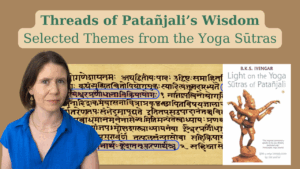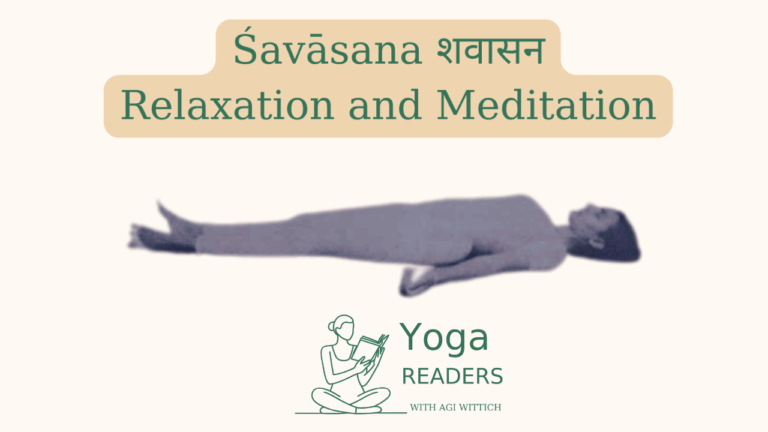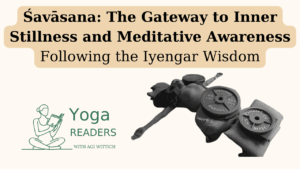
Threads of Patanjali’s Wisdom – Online Course
A course of selected themes from the Yoga Sutras with Dr. Agi Wittich The Yoga Sūtras of Patañjali are the philosophical heart of yoga.

From Book Session: Unit 8 of Geeta Iyengar's Yoga a Gem for Women: Prāṇāyāma and Meditation
In the vast repertoire of yoga āsanas, Śavāsana (Corpse Pose) holds a unique and profound position. As Geeta Iyengar explains in “Yoga: A Gem for Women,” “Although Śavāsana appears simple, it is most difficult to master. The body and the mind are interdependent and interconnected. They are inseparable in the art of introspection.”
The significance of this pose extends far beyond mere physical relaxation. “Śavāsana is a link connecting the body and the mind; it connects āsana and prāṇāyāma and leads one to the spiritual path,” Geeta elaborates. This understanding positions Śavāsana as a crucial bridge between external and internal practices. This echoes Guruji’s emphasis in his book “Light on Life” Chapter 2: Stability – The Physical Body (Asana) that physical steadiness opens portals to inner consciousness.
The practice requires meticulous attention to detail. As Geeta describes, every aspect of the body must be consciously adjusted – from the placement of the shoulders to the position of the eyes. “Broaden and flatten the buttocks so that the flesh in this area does not become tight, especially in the small of the back,” she instructs. “Move the hands towards the head to adjust it and place the back of the head centrally on the floor.”
Perhaps most profound is the pose’s deeper significance: “Śavāsana is like an experience of death in a living state. For a brief period the body, the mind, and the speech are still… Unlike in the dead body, however, the soul exists – it exists in a pure state.” This paradoxical state of conscious stillness creates what Geeta calls “a new state of consciousness, with no movement and so no waste of energy.”
The relationship between body and breath takes on particular importance. “The movement of breathing should not disturb the trunk, the limbs, and the brain,” Geeta emphasizes. This subtle awareness of breath leads to what she describes as “perfect relaxation, where the mind remains unperturbed and an inward flow of energy is experienced.” Such restorative capacity makes Śavāsana an ideal practice across women’s life cycles—from pregnancy to menopause—as explored in Women’s Life Cycles: A Yogic Perspective.
The practice involves systematic relaxation of every part of the body. “Relax the skin of the forehead, the cheeks, the lips, the hands, the sides of the trunk, the buttocks, and the thighs,” Geeta instructs. However, this relaxation is not passive. As she notes, “direct the brain and the eyes towards the heart centre.” This active awareness distinguishes Śavāsana from ordinary rest.
The mental aspect of the practice is equally crucial. “The interrelation of the eyes, the mind, and the brain is very important,” Geeta explains. “If the mind wanders, the brain moves upward and the eyes too become unsteady.” The practitioner must learn to “draw in the eyes and ears, draw them inwards and fuse them at a point inside the centre of the chest where external sounds cease to disturb.”
The ultimate goal is what Geeta describes as “surrender yourself, your body and mind to Mother Earth so that you are calm and passive. This is total relaxation.” Through this practice, one experiences what she calls “freedom of the mind and freedom of the body.”
The benefits are comprehensive. “Śavāsana is invigorating and refreshing,” Geeta notes. “It helps the body and the mind to recuperate after long and serious illnesses.” She particularly emphasizes its value for those suffering from “respiratory diseases, heart trouble, nervous tension, and insomnia” as it “soothes the nerves and calms the mind.”
Most importantly, Śavāsana is not just about physical rest but about entering a state of meditative awareness. As Geeta concludes, “It is not simply lying flat on the back. It is a state of meditation.” Through regular practice, one learns to access deeper levels of relaxation while maintaining conscious awareness, making Śavāsana truly “control over the inner world and surrender to the Supreme Being.” For those curious about how Śavāsana integrates with the layers of the self, see my guide on The Pañca Kośas: Understanding the Five Sheaths in Yoga, which unpacks the mind–body alignment embedded in this pose.
The mastery of Śavāsana requires patience, dedication, and systematic practice. As B.K.S. Iyengar emphasized, this seemingly simple pose contains profound depths, offering practitioners a gateway to understanding the subtle relationship between body, breath, and consciousness.
If you find this article helpful, feel free to Buy me a chai to support my work.
Want to discuss your practice or have questions? Talk Yoga with Agi anytime—it would be my pleasure to connect with you.

A course of selected themes from the Yoga Sutras with Dr. Agi Wittich The Yoga Sūtras of Patañjali are the philosophical heart of yoga.

In a recent Yoga Readers session, Dr. Lois Steinberg opened her teaching archives and personal memories, sharing stories that span four decades of study

In the vast and intricate repertoire of yoga āsanas (postures), Śavāsana (Corpse Pose) holds a unique and profoundly significant position. Often superficially perceived as
Agi Wittich is a yoga practitioner since two decades, and is a certified Iyengar Yoga teacher. Wittich studied Sanskrit and Tamil at the Hebrew University of Jerusalem, Israel, completing a PhD with a focus on Hinduism, Yoga, and Gender. She has published academic papers exploring topics such as Iyengar yoga and women, the effects of Western media on the image of yoga, and an analysis of the Thirumanthiram yoga text.